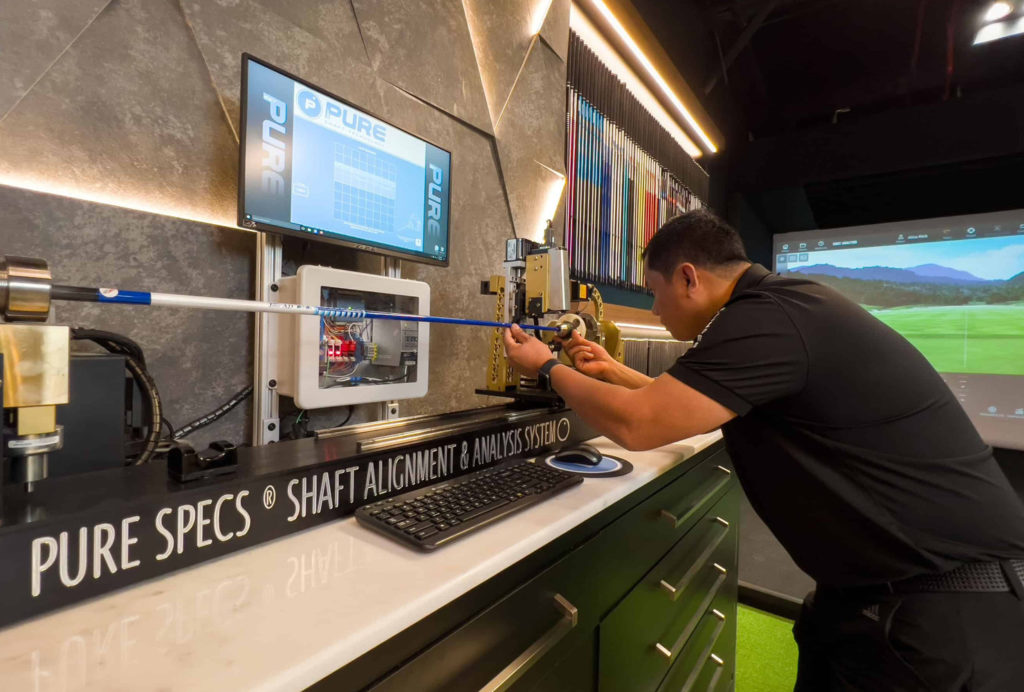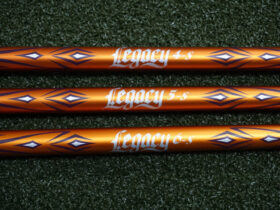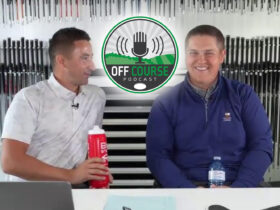Brand Story: The Origins of SST PURE
The story of SST PURE brings up a number of thoughts and feelings ranging from incredibly innovative to not necessary and everything in between. Despite the plight, getting from origin to present is about as interesting as anything we have covered in the series. To understand where they are now, let’s go back to a few decades and meet Dick Weiss.

Weiss was an accomplished golfer. He played on the US Pan American Cup team in the 60s, won the Broward County Am in the 80s and even qualified for the national long drive championship. He loved the game, the gear, and the golf lifestyle.
In the mid 90s he and his brother invested in a golf course in Miami. Around the same time, a friend partnered with him on a club repair business that was near the driving range. Building and repairing equipment had been a hobby since Dick was a kid and he was doing the work for many of his customers in the banking business (his previous profession). It was around this time that Weiss founded the business SST PURE, which stands for Strategic Shaft Technologies Plane of Uniform Repeatability.
Before jumping ahead to the business model though, we have to explain how the device itself, and the process, happened by accident. Josh from SST PURE shares that story.

“He was testing a new shaft extractor he had developed with a graphite shaft. He pulled the shaft of his driver and decided he did not want to see the brand logo at address. He reassembled the club with the logo facing down. When he went to the practice range to hit it, the club performed differently, and had a much better feel. He had a couple of backups of the same head and shaft. He repeated the process he had done with the first driver, and reassembled with the logo facing down, but did not have the same performance in the backup drivers. Mr. Weiss had always been curious as to why seemingly identical clubs, direct from manufacturers, did not always perform the same. Given what he’d experienced with his “logo down” drivers, he decided to cut the first shaft in half to have a look inside. He discovered that one side of the shaft was thicker than the other. At that point, Mr. Weiss started to patent his processes for aligning shafts.
A decade or so earlier, a man named Robert Colbert had discovered a similar issue with steel shafts. The clubs were used by his daughter, an LPGA Tour player at the time, and were direct from an OEM. When he looked at the cross-section of the shaft, there was a seam. This seam is created by the heating, rolling, and joining of the ends of the piece of steel that becomes a shaft. Colbert patented the process for assembling a golf club in any way other than randomly, which had been the way clubs were assembled.
Mr. Weiss had always intended to bring his process to the USGA to be conforming to the Rules of Golf. To that end, he met with Mr. Colbert and purchased Colbert’s existing patent. From there, Weiss developed and patented the apparatus and method for identifying shaft irregularities. When he reached out to the USGA there was a fair amount of resistance, initially. The Rules of Golf forbid the alignment of a shaft to induce a specific ball flight. After about two years, Mr. Weiss was granted a relief under Appendix 2, Rule 4-1b. From there, Mr. Weiss began to license his machine and process to OEMs, club makers, and component distributors.”

Weiss decided to dedicate the majority of his time on the PGA Tour as a club builder. For seven years he was out there week in and week out building clubs for the best players in the world.
In 1999, the USGA approved shaft PUREing on tour. Within 36 months, more than 100 PGA Tour players were using PUREd shafts. The first player to have it done was Bruce Lietzke and the most popular player in the world, Tiger Woods, has been PUREing his irons for a long time.
So decades ago, a couple of driver swings by Dick Weiss led to some unique conclusions. Here we are at the turn of the century and the top players in the world are getting the work done. In golf, things evolve, including the manufacturing process for shafts, so how has SST PURE adjusted? Is the machine the same as it was back in 1999 on Tour? Obviously not, and Josh from SST expands on that.
“The PUREing machines have always been computer-based. Meaning the shaft analysis was done via computer, which was what set PUREing apart from other shaft alignment procedures at the time. Obviously over two decades the software has improved. The other big change is that the machines used to be hand-operated for the shaft testing. Now they are fully automated. The operator inputs the shaft’s specs, inserts the shaft, attaches the end weight, presses start and the machine does the rest.”

If you want to see how the machine actually works, we filmed one in action last year. You can watch it go to work here.
It seems like second nature now, but up until 2004-2005, drivers were not all that adjustable to the regular golfer. TaylorMade brought that first with the Quad, which allowed you to change the placement of weighting and potentially the ball flight. In 2008, Callaway released the I-Mix driver. Around that same time, Nickent released the Evolver. Shortly after those came to market, companies started releasing adjustable drivers that were more than just weights to alter ball flight or interchangeable shafts, but actually rotating shafts that could alter the loft or face angle of the club head.
While Callaway seemed ahead of the curve with the dual cog, which doesn’t change the shaft orientation, despite the ability to alter loft and face angle independently, many companies still today use adapters that will move based on the settings the golfer wants. Has that had an impact on PUREing? Josh from SST gave some insight.
“Adjustability probably hasn’t had too much impact on how PUREing is thought of as far as it’s viability or necessity. Just like with older non-adjustable clubs, the shaft is aligned and installed in the PUREd position. It should be noted that, adjusting the shaft does take it out of the PUREd position. This is an issue with Drivers, fairway woods and hybrids. One question we get a lot is
“I was fit for a driver at X loft with a PUREd shaft. I want to adjust the loft, will that affect the PUREing?”
You can apply this idea to fairways and hybrids as well. No matter the club, the answer is that rotating a PUREd shaft will absolutely affect the PUREing. If the adapter tip was installed to set the club at a certain loft, and the shaft was aligned to be in that position, it is only PUREd in that position. Rotating it will change the aligned position. At this point, the player is no longer receiving the benefits of PUREing. The way to adjust your PUREd shaft and maintain the benefits of PUREing is to have the shaft pulled from the adapter, and realigned to the desired adapter setting in the PUREd position, then re-installed.”

This brings up a pretty interesting segue. Does PUREing or even the thought of this as a necessary option mean the manufacturers are not making high quality products? The answer is no. Not at all. We asked Josh from SST PURE what is a rough perfentage of equipment that are not to exact spec off the rack?
“That’s difficult to answer directly. All manufacturers build to tight tolerances. There aren’t necessarily industry standards on all specs though. Furthermore, issues arise in the process of manufacturing shafts. The raw materials to build shafts don’t naturally exist in their rounded, finished shape. Therefore, inconsistencies in the shaft will occur during the manufacturing process. Additionally, shaft labels and graphics are often applied to a random spot on the shaft. Once the label or graphics are on, it is natural to align the head and grip with the label or graphics. But if that shaft wasn’t analyzed and the graphics or labels applied to a specific position based on the analysis, there is little chance that the shaft will be in the PUREd position [off the rack].”
We started this with the origin of SST PURE and how it was an idea, or even an accident that with in a handful of years had over 100 of the best players in the world having the work done. The evolution that both the equipment being PUREd and the PUREing equipment have gone through, yet there is still another piece to the puzzle and that is, is it necessary? The answer is no, with a caveat.
Nobody has to have PUREing done. Nobody has to buy new golf equipment or change shafts or get fit or anything else to enjoy this game. But for the person that spends the time to do all of those things, that focuses on the RPMs of the data on the launch monitor, the degrees at which the ball flight takes off and lands and the speed in which all of these take place, then the bigger question would be why not?
Sure there is a small added cost for the service (not always), but there won’t ever be any harm. If it works, or even if it is just placebo, the peace of mind offered knowing a computer analyzed and placed the shaft in what it believes is the best orientation possible, is as real as the mental side of this game.

As we wrap up this Brand Story, we always like to finish with something of a crystal ball. In this instance, it is really twofold. What does the future hold for SST PURE and really what does it hold for the PUREing process? We asked Josh from SST to expand.
“As a brand, we are continuing to grow. There is more awareness of PUREing and education about its benefits now than ever before. More golfers of all skill levels are seeing the benefits of shaft PUREing. We think it speaks volumes when touring professionals – golfers with the highest skill level – have their shafts PUREd. Improving performance at the highest level is found on the margins. These players have access to every brand of shaft, and manufacturers send the shafts of the tightest tolerances to the Tour trucks for the professionals. Given that array of products to choose from, if a tour pro still insists on shaft PUREing, it says that the process is a difference maker.
The process of shaft PUREing can be applied to other industries, particularly other sporting equipment. The technology works for arrows in archery, fishing rods, baseball bats, and badminton rackets. We’ll be looking to take this great technology to those industries.”
Other industries makes a lot of sense. There are no shortage of round objects in many sports and leisure activities.
Have you thought about getting your shafts PUREd? SST has put together an easy to use search to find out where you can get more info in your area. Check it out on their website here.
If you would like to learn more about the PUREing process, do not forget to check out www.sstpure.com.












Thanks for sharing.
That was a very fun part of the story to learn.
One parallel I can think of that could be a future place to grow is from the guitar industry. There is a machine called PLEK that uses an automated program to detect inconsistencies in the instrument and make necessary changes to offer the best playability. It used to be almost exclusively an aftermarket process you paid for. Some manufacturers and retailers ended up buying the machines and incorporating their use pre-purchase. For retailers it was an upsell opportunity and for manufacturers it was the chance to add value and (the appearance of) premium quality to their products.
Also, I seem to recall many shafts I have purchased new in the past (Aldila NV comes to mind) that had/have a mark on the butt end of the shaft a line – always wondered if that was from some kind of PUREing or from manufacture.
Anyway the article made me think about this stuff – so thanks for that JB!
Any idea what % of builds that the OEMS or Club Champion do that are PUREd?
I agree with @jdtox that it would be better if the shaft manufacturers did this before applying the graphics but I’m not sure it would be worthwhile for them to interrupt the process like that.
I have a few friends who’ve had it done. Some believe in it, others believe it’s hogwash. I’ve read the same things on the forum. I suppose if you believe it, it works.
I honestly do not, but can do some checking.
Interesting history and story to how it all started. I know a lot of people swear by this, but i always wonder how much it truly affects things for the average golfer. It is remarkable the traction they have gotten, and some of the nanes that PURE their shafts.
Thanks again for doing these. Love it!!
I did go and watch the video from last year of the process and was kind of shocked at the variance shown in the charts on the machine.
This was where it got intriguing for me. Not because I believe having this done changes the dynamic of the game giving me slews of more distance or consistency, but watching a random shaft, that I happen to grab out of the box, come up so differently than others means "why not".
I just wished they shared what the actual measurements or scale on the chart is.
Makes it real hard for me to get behind this at all.
I think for irons is where this would really make difference. If you’re expecting them all to feel exactly the same and there is some variation amongst the set it matters.
What is the thinking behind picking the stiffest part of the shaft to orient the shaft?
Yeah that’s a fair point
Consistency. It is done in Archery for example to make sure every one is consistent.
That is really the million dollar question. I guess you could make the same case for testing any shaft though.
Of course, I get that as well. There are just so many variables that control a shot’s results, it’s tricky to really pinpoint what controlled the result.
This feels right up there with someone with magnet bracelets. I have no idea if it works, but I have no way of determining that it doesn’t work just the same.